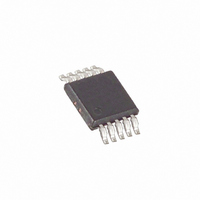MAX9924UAUB+ Maxim Integrated Products, MAX9924UAUB+ Datasheet - Page 12

MAX9924UAUB+
Manufacturer Part Number
MAX9924UAUB+
Description
IC SENSOR INTERFACE VARI 10MSOP
Manufacturer
Maxim Integrated Products
Type
Sensor Interfacer
Datasheet
1.MAX9927AEE.pdf
(23 pages)
Specifications of MAX9924UAUB+
Input Type
Differential
Output Type
Logic
Interface
Differential
Current - Supply
5mA
Mounting Type
Surface Mount
Package / Case
10-MSOP, Micro10™, 10-uMAX, 10-uSOP
Lead Free Status / RoHS Status
Lead free / RoHS Compliant
Variable Reluctance Sensor Interfaces with
Differential Input and Adaptive Peak Threshold
Table 1. MAX9924/MAX9926 Operating Modes
Table 2. MAX9925 Operating Modes
Table 3. MAX9927 Operating Modes
12
The MAX9924–MAX9927 interface with variable reluc-
tance (VR) or magnetic coil sensors. These devices
produce accurate pulses aligned with flywheel gear-
teeth even when the pickup signal is small and in the
presence of large amounts of system noise. They inter-
face with new-generation differential VR sensors as well
as legacy single-ended VR sensors.
The MAX9924/MAX9925 integrate a precision op amp,
a precision comparator, an adaptive peak threshold
block, a zero-crossing detection circuit, and precision
matched resistors (MAX9924). The MAX9926 and
MAX9927 are dual versions of the MAX9924 and
MAX9925, respectively. The MAX9926 also provides a
rotational output that is useful for quadrature-connected
VR sensors used in certain high-performance engines.
The input op amp in the MAX9925/MAX9927 are typical-
ly configured as a differential amplifier by using four
external resistors (the MAX9924/MAX9926 integrate
precision-matched resistors to give superior CMRR per-
formance). This input differential amplifier rejects input
common-mode noise and converts the input differential
signal from a VR sensor into a single-ended signal. The
internal comparator produces output pulses by compar-
OPERATING MODE
OPERATING MODE
______________________________________________________________________________________
OPERATING MODE
A1
A2
A1
B
C
C
B
A1
B
Detailed Description
ZERO_EN
ZERO_EN
GND
GND
V
V
CC
CC
GND
V
V
CC
CC
SETTING
SETTING
INT_THRS
SETTING
GND
INT_THRS
V
CC
GND
GND
V
V
CC
CC
INT_THRS
GND
V
V
CC
CC
ZERO CROSSING
Disabled
ZERO CROSSING
Enabled
Enabled
Enabled
ing the output of the input differential amplifier with a
threshold voltage that is set depending on the mode
that the device is in (see the Mode Selection section).
The MAX9924/MAX9926 provide four modes of opera-
tion: Mode A1, Mode A2, Mode B, and Mode C as deter-
mined by voltages applied to inputs ZERO_EN and
INT_THRS (see Tables 1, 2, and 3). In Modes A1 and
A2, the internal adaptive peak threshold and the zero-
crossing features are enabled. In Mode A2, an internally
generated reference voltage is used to bias the differen-
tial amplifier and all internal circuitry instead of an exter-
nal voltage connected to the BIAS input—this helps
reduce external components and design variables lead-
ing to a more robust application. In Mode B, the adap-
tive peak threshold functionality is disabled, but
zero-crossing functionality is enabled. In this mode, an
external threshold voltage is applied at EXT allowing
application-specific adaptive algorithms to be imple-
mented in firmware. In Mode C, both the adaptive peak
threshold and zero-crossing features are disabled and
the device acts as a high-performance differential ampli-
fier connected to a precision comparator (add external
hysteresis to the comparator for glitch-free operation).
ZERO CROSSING
Enabled
Enabled
Disabled
Enabled
Enabled
DEVICE FUNCTIONALITY
DEVICE FUNCTIONALITY
DEVICE FUNCTIONALITY
ADAPTIVE PEAK
THRESHOLD
Disabled
Disabled
Enabled
Enabled
ADAPTIVE PEAK THRESHOLD
ADAPTIVE PEAK THRESHOLD
Disabled
Enabled
Mode Selection
Disabled
Disabled
Enabled
BIAS VOLTAGE
Internal Ref
SOURCE
External
External
External












